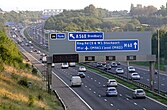Transport in England includes road, rail, air, and water networks.[1]
A radial road network totals 29,145 miles (46,904 km) of main roads, 2,173 miles (3,497 km) of motorways and 213,750 miles (344,000 km) of paved roads. The National Rail network of 10,072 route miles (16,116 km) in Great Britain carries over 18,000 passenger and 1,000 freight trains daily. Urban rail networks and bus networks connecting cities and towns are widespread.
There are many regional and international airports, with Heathrow Airport in London being the second busiest in the world and the busiest in Europe.[2] Transport by canal and navigable river, once important, is minimal. Shipping provides the primary means of transport for import and export of goods.
The Department for Transport is the government department responsible for the transport network in England. The Secretary of State for Transport is the member of the cabinet responsible to Parliament for the Department for Transport.[3]
- ^ "Travel and transport". British Council.
- ^ "Europe's Busiest Airports". Business Traveler USA. 12 April 2023. Retrieved 8 November 2023.
- ^ "Secretary of State for Transport - GOV.UK". www.gov.uk. Retrieved 5 March 2020.



